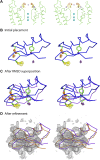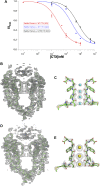Structure of a pore-blocking toxin in complex with a eukaryotic voltage-dependent K(+) channel
- PMID: 23705070
- PMCID: PMC3660741
- DOI: 10.7554/eLife.00594
Structure of a pore-blocking toxin in complex with a eukaryotic voltage-dependent K(+) channel
Abstract
Pore-blocking toxins inhibit voltage-dependent K(+) channels (Kv channels) by plugging the ion-conduction pathway. We have solved the crystal structure of paddle chimera, a Kv channel in complex with charybdotoxin (CTX), a pore-blocking toxin. The toxin binds to the extracellular pore entryway without producing discernable alteration of the selectivity filter structure and is oriented to project its Lys27 into the pore. The most extracellular K(+) binding site (S1) is devoid of K(+) electron-density when wild-type CTX is bound, but K(+) density is present to some extent in a Lys27Met mutant. In crystals with Cs(+) replacing K(+), S1 electron-density is present even in the presence of Lys27, a finding compatible with the differential effects of Cs(+) vs K(+) on CTX affinity for the channel. Together, these results show that CTX binds to a K(+) channel in a lock and key manner and interacts directly with conducting ions inside the selectivity filter. DOI:http://dx.doi.org/10.7554/eLife.00594.001.
Keywords: Ion Channel; None; Scorpion toxin; Toxin; Voltage-dependent K+ Channel.
Conflict of interest statement
The authors declare that no competing interests exist.
Figures













Comment in
-
The scorpion toxin and the potassium channel.Elife. 2013 May 21;2:e00873. doi: 10.7554/eLife.00873. Elife. 2013. PMID: 23705072 Free PMC article.
References
Publication types
MeSH terms
Substances
Grants and funding
LinkOut - more resources
Full Text Sources
Other Literature Sources
Molecular Biology Databases

